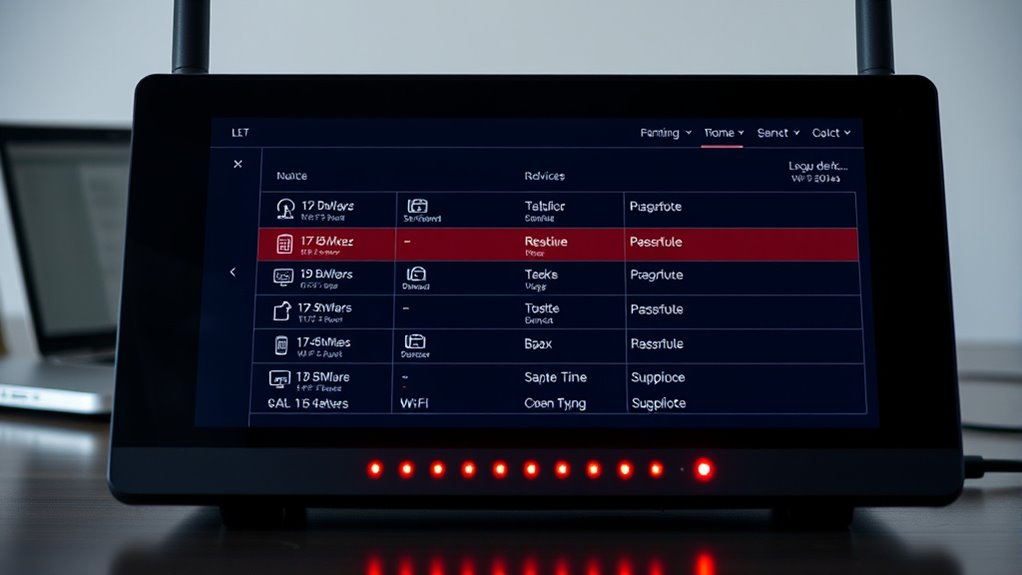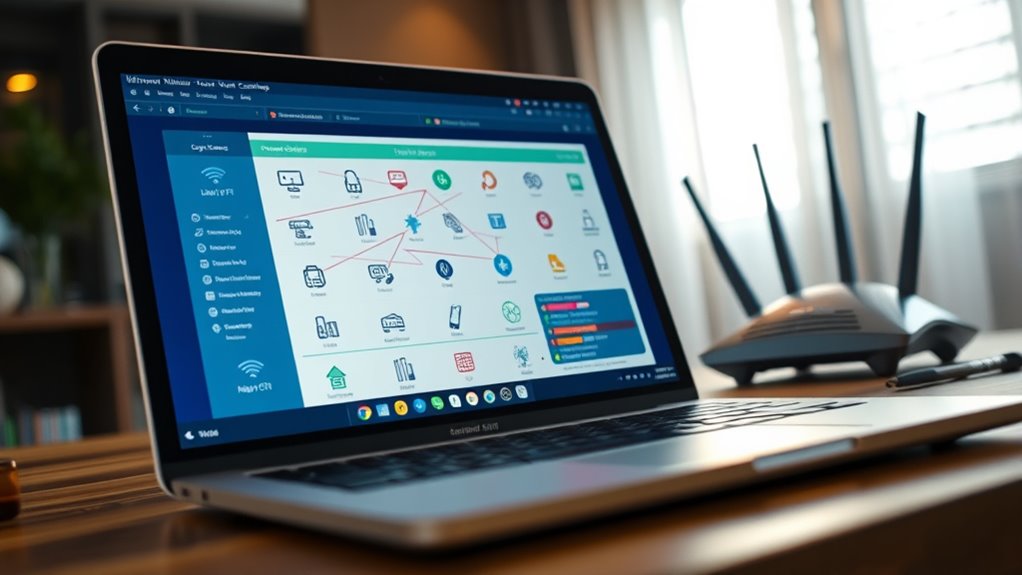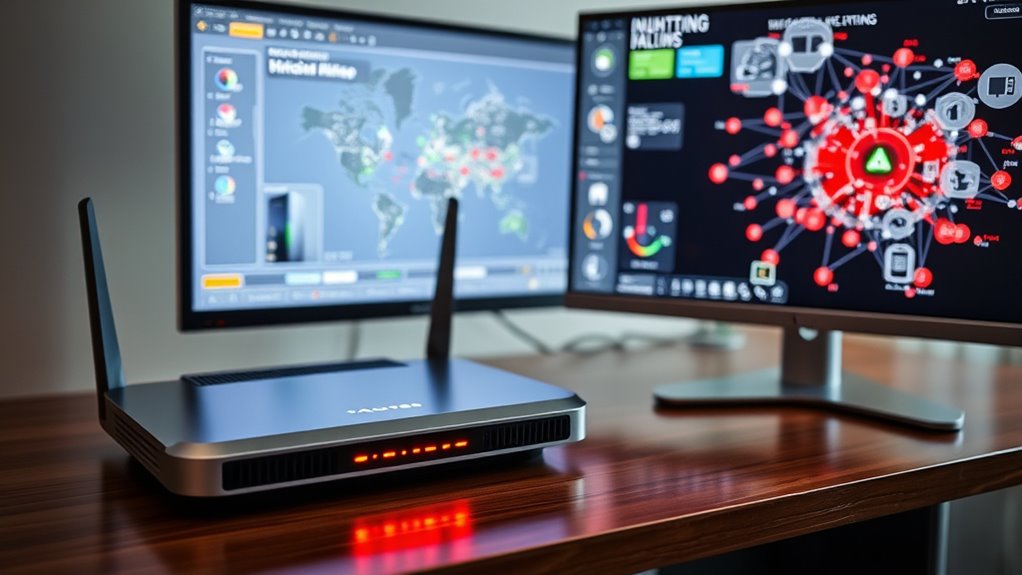To detect rogue IoT devices on your Wi-Fi in five minutes, start by logging into your router’s admin panel and checking the list of connected devices. Look for unfamiliar names, IPs, or signals that seem out of place. Use network scanning tools to identify hidden devices, analyze details like manufacturer or firmware, and set up alerts for new connections. Implementing these steps quickly can help protect your network—discover more tips below.
Key Takeaways
- Log into your router’s admin panel and review connected devices for unfamiliar or suspicious entries.
- Use network scanning tools to quickly identify unknown devices by MAC and IP address analysis.
- Check device details, such as manufacturer and firmware, to spot anomalies or outdated, vulnerable devices.
- Enable alerts for new device connections to receive immediate notifications of rogue device appearances.
- Implement network segmentation or VLANs to isolate and contain rogue IoT devices promptly.
Check Your Router’s Device List

To identify any rogue IoT devices on your network, start by checking your router’s device list. Log into your router’s admin panel and review the connected devices. Look for unfamiliar names or IP addresses that don’t match your known devices. Pay attention to unusual network traffic, which can indicate unauthorized activity. If a device seems suspicious, check whether it’s running outdated firmware, as outdated firmware can be a security risk. Regular firmware updates help patch vulnerabilities and protect your network. Remove any devices you don’t recognize or trust. Keeping a close eye on your device list allows you to catch rogue IoT devices early before they can cause security issues or consume unnecessary bandwidth. Understanding industry trends aids in job acquisition and staying informed about new security threats can help you better manage your network.
Identify Unrecognized Devices

You should regularly check your device list for unknown entries. Look for devices with unfamiliar names or suspicious labels. Identifying these unrecognized devices helps you catch potential threats early. Additionally, monitoring for suspicious activity on your network can help detect rogue devices attempting to access your Wi-Fi without authorization.
Spot Unknown Devices
How can organizations quickly identify unrecognized devices lurking on their networks? The key is to monitor device authentication logs and network traffic for unfamiliar connections. Use network scanning tools that spot devices not listed in your approved inventory. Keep firmware updates current, as outdated firmware can expose vulnerabilities that rogue devices exploit. Implementing strict authentication protocols ensures only authorized devices connect, making it easier to spot unknown ones. Regularly review device signatures and behavior patterns to flag anomalies. Automating these processes enables rapid detection, so you can respond before a rogue device causes harm. Staying vigilant with timely firmware updates and robust device authentication helps you maintain control over your network, making it tougher for unauthorized devices to slip through unnoticed. Additionally, incorporating device management best practices can further enhance your ability to detect and prevent rogue devices.
Check Device Names
Checking device names can quickly reveal unrecognized or suspicious devices on your network. Look for unusual device name patterns, such as generic labels or random strings, which may indicate rogue devices. Also, pay attention to firmware inconsistencies—devices with outdated or mismatched firmware versions often signal unauthorized access. Rogue IoT devices might use default names or mimic legitimate device names to blend in, so spotting irregularities helps you identify potential threats. If a device’s name doesn’t match expected naming conventions or seems out of place, investigate further. Regularly monitoring device names allows you to catch unauthorized devices early, before they can cause harm or compromise your network security. Being vigilant about these details is a simple but effective step in safeguarding your Wi-Fi. Additionally, device identification techniques can help verify whether connected devices are legitimate or potentially malicious.
Use Network Scanning Tools

To detect rogue IoT devices effectively, you need to select the right network scanning tools that fit your environment. Once you perform a scan, you can gather detailed data about connected devices. Analyzing this information helps you identify unfamiliar or unauthorized devices quickly. Utilizing hydrocolloid technology can also aid in understanding how certain patches promote healing, similar to how network tools promote device security.
Choose Suitable Tools
Selecting the right network scanning tools is essential for effectively identifying rogue IoT devices on your network. You need tools that support thorough network monitoring, allowing you to spot unfamiliar devices quickly. Look for solutions that offer real-time visibility and detailed device information, such as MAC addresses, IPs, and device types. These tools should also facilitate device authentication checks, helping you verify whether connected devices are authorized. Choose scanners that are user-friendly and compatible with your network setup, whether it’s a small home network or a large enterprise environment. Prioritize tools with alerting features to notify you of suspicious devices. By selecting appropriate network scanning tools, you lay a solid foundation for rapid detection and enhanced security against rogue IoT threats. Understanding basic network security principles can further improve your ability to protect your network effectively.
Perform Network Scan
Performing a network scan using the right tools is the next step in identifying rogue IoT devices. This process reveals all connected devices, their IP addresses, and wireless signal strengths, helping you spot unfamiliar devices. Use network scanning tools to visualize your network topology, which shows how devices connect and communicate. Recognize unusual entries that don’t belong or show weak signals inconsistent with your setup. To help, here’s a quick overview:
| Device Type | Signal Strength | Location in Network Topology |
|---|---|---|
| Known IoT Devices | Strong | Central Hub |
| Rogue Device | Weak/Unrecognized | Perimeter/Edge |
| Your Smartphone | Moderate | Connecting to Router |
| Unknown Device | Varies | Unusual Pathways |
This step uncovers hidden threats and prepares you for detailed analysis. Understanding contrast ratio can help you interpret the visibility of devices on your network, especially when dealing with weak signals or obscure connections.
Analyze Device Data
How can you determine which devices are legitimate and which might be rogue once you’ve completed a network scan? By analyzing device data, you can identify unfamiliar or suspicious devices through device fingerprinting, which reveals unique hardware and software signatures. Look for anomalies, such as unexpected device types, unusual network behavior, or mismatched device characteristics. Using anomaly detection tools, you can flag devices that deviate from normal patterns, highlighting potential threats. Comparing device fingerprints against known profiles helps confirm legitimacy or spot rogue devices. This step sharpens your focus on suspicious activity, enabling quicker responses. Effective analysis of device data empowers you to distinguish legitimate IoT devices from malicious actors lurking on your network.
Analyze Device Names and Details

Analyzing device names and details is a crucial step in identifying rogue IoT devices on your network. Start by examining device naming conventions; legitimate devices often follow consistent naming patterns, while unfamiliar or oddly named devices may be suspicious. Conduct device detail analysis to uncover key information like manufacturer, model, and firmware version, which can reveal discrepancies or unknown origins. Look for devices with generic or unusual names that don’t match your known devices. Cross-reference device details with your inventory to spot anomalies. This process helps you quickly filter out potential threats before they cause harm. Paying close attention to textile art techniques and design elements can also inspire more secure network practices. By paying close attention to device names and details, you gain valuable insights into your network’s device landscape, making it easier to detect unauthorized or rogue IoT devices.
Block Suspicious Devices

Have you identified suspicious devices on your network? Now, it’s time to block them to protect your Wi-Fi. Start by monitoring your network traffic for unusual spikes or unfamiliar device behavior. Many routers let you view connected devices and their activity. Once you spot devices that behave oddly or don’t match your expectations, you can block them directly through your router’s admin panel. This prevents rogue IoT devices from accessing your network further. Some routers even allow you to set rules to automatically block devices exhibiting suspicious activity. Remember, the goal is to cut off any potential security threats quickly. By acting swiftly to block suspicious devices, you reduce the risk of data breaches or malicious control over your network. Regularly reviewing gadget protection tips can also help strengthen your defenses.
Enable Network Segmentation

After blocking suspicious devices, the next step is to implement network segmentation. This limits rogue devices’ access and isolates IoT gadgets from your main network. Start by configuring VLANs to separate different device groups, such as smart home devices and personal computers. Proper VLAN configuration guarantees that even if a rogue device slips through, it can’t access sensitive information or critical systems. Use access control to enforce restrictions between segments, allowing only necessary communication. Remember these key points:
- Segment IoT devices into dedicated VLANs for better control.
- Apply strict access controls to limit device-to-device communication.
- Regularly review VLAN configuration to adapt to new devices or threats.
- Incorporate AI detection methods to identify and mitigate potential security breaches more effectively.
Network segmentation enhances security by creating barriers that rogue devices can’t bypass.
Set Up Alerts for New Devices

Setting up alerts for new devices is essential to maintaining your network’s security. By configuring your router security settings, you can receive immediate notifications whenever a new device connects. This allows you to quickly identify unauthorized or rogue IoT devices before they cause harm. Keep in mind that device firmware updates improve security, so ensure your routers and connected devices are up to date. Many routers offer built-in alert features or allow third-party monitoring tools to notify you of new connections. Regularly reviewing these alerts helps you stay aware of your network’s activity and respond promptly to suspicious devices. Staying proactive with alerts not only enhances security but also gives you peace of mind knowing you’re in control of your connected environment.
Regularly Monitor Your Network

Regularly monitoring your network is essential for detecting and preventing unauthorized devices from gaining access. Consistent checks help you catch rogue IoT devices early, especially when wireless interference affects network performance. Use network monitoring tools to identify unusual activity or new connections.
To optimize security, remember to:
- Keep firmware updates current for all devices, closing vulnerabilities.
- Watch for wireless interference that could mask rogue device activity.
- Regularly scan connected devices to spot unfamiliar or unauthorized ones.
Staying proactive ensures your network remains secure. Monitoring helps you spot anomalies caused by interference or device behavior, giving you a chance to act swiftly before any damage occurs.
Frequently Asked Questions
How Can I Differentiate Between Legitimate and Rogue Iot Devices?
To tell legitimate from rogue IoT devices, start with device fingerprinting, which analyzes device behaviors and characteristics. Rogue devices often have unusual patterns or unknown signatures. Also, implement network segmentation to isolate IoT devices from critical assets, making it easier to spot anomalies. By combining device fingerprinting with segmentation, you can quickly identify suspicious devices and prevent potential security threats on your Wi-Fi network.
Are There Specific Signs Indicating a Device Has Been Compromised?
You can tell if a device’s been compromised by observing unusual device behavior, like unexpected restarts or data spikes. Firmware anomalies, such as strange updates or corrupted software, also signal potential issues. If your device acts differently or shows signs of tampering, it’s likely compromised. Regularly monitor network activity and firmware updates to catch these signs early and protect your network from threats.
What Are the Best Practices for Securing Iot Devices on My Network?
To secure your IoT devices, you should implement device segmentation, isolating them from your main network to limit potential threats. Regularly update their firmware to patch security vulnerabilities and improve performance. Use strong, unique passwords and enable multi-factor authentication where possible. Keep track of connected devices and monitor network activity for unusual behavior. These best practices help protect your network from unauthorized access and cyber threats.
How Often Should I Perform Network Scans for Rogue Devices?
You might think frequent scans are annoying, but consistent network monitoring is vital. To catch rogue devices early, perform scans weekly or bi-weekly, especially if you add new IoT gadgets or notice unusual activity. Regular checks, combined with robust device authentication, help make sure your network stays secure. This proactive approach minimizes vulnerabilities, keeping unauthorized devices out and protecting your data from potential threats.
Can I Automate the Detection of New or Suspicious Devices?
Yes, you can automate the detection of new or suspicious devices. Use device fingerprinting to identify and flag unfamiliar hardware, and implement network segmentation to isolate potentially risky devices. Automated tools can continuously monitor your network, alerting you to any anomalies or unauthorized connections. This proactive approach helps you stay ahead of rogue IoT devices, ensuring your network remains secure without manual oversight.
Conclusion
By staying vigilant, you’re the lighthouse guiding your network through the fog of rogue devices. Regularly checking your router’s device list and using scanning tools is like shining a spotlight in the darkness, revealing hidden threats. Block suspicious devices and set up alerts to keep your Wi-Fi fortress secure. With consistent monitoring, you’re the master conductor, ensuring your digital symphony remains harmonious, safe from intruders lurking in the shadows.









